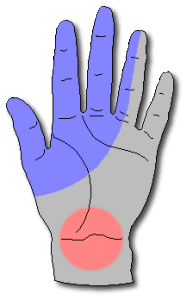 Carpal Tunnel Syndrome (CTS) is a common peripheral entrapment that causes neuralgia in the median nerve distribution of the hand. Wait, what? Translated from “medi-speak”. The carpal tunnel is an archway of bones in your wrists. When you palm is face-up, the bony arch is upside down. Across the open end of the arch, a thick band of connective tissue (flexor retinaculum) crosses to close off the arch and forms a “tunnel”. This tunnel is the way for tendons in your forearm to control muscles in your hand. There’s also a median nerve that supplies nerve function to some of the muscles at the base of your thumb and first two fingers. Sometimes Carpal Tunnel Syndrome is referred to as Median Nerve Syndrome. Continue reading “Carpal Tunnel: Is this You?”
Carpal Tunnel Syndrome (CTS) is a common peripheral entrapment that causes neuralgia in the median nerve distribution of the hand. Wait, what? Translated from “medi-speak”. The carpal tunnel is an archway of bones in your wrists. When you palm is face-up, the bony arch is upside down. Across the open end of the arch, a thick band of connective tissue (flexor retinaculum) crosses to close off the arch and forms a “tunnel”. This tunnel is the way for tendons in your forearm to control muscles in your hand. There’s also a median nerve that supplies nerve function to some of the muscles at the base of your thumb and first two fingers. Sometimes Carpal Tunnel Syndrome is referred to as Median Nerve Syndrome. Continue reading “Carpal Tunnel: Is this You?”
Tag: therapeutic massage
Breaking the Pain Cycle
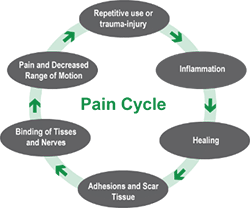 A recent study conducted at the Center on an Aging Society at Georgetown University found that back pain is the most common cause of workdays lost in the US. It is the 2ndmost common cause of visits to the doctor’s office and experts estimate that 80% of the population will have a back pain issue at some point in their lives. Not only are we a society in pain, but when it gets bad enough we lose work, money, and then have to pay in an attempt to relieve the pain. Many of us are currently facing these problems and are met with the question of how do I get better and how do I decrease the likelihood that the pain will return. One answer is understanding and breaking the pain cycle.
A recent study conducted at the Center on an Aging Society at Georgetown University found that back pain is the most common cause of workdays lost in the US. It is the 2ndmost common cause of visits to the doctor’s office and experts estimate that 80% of the population will have a back pain issue at some point in their lives. Not only are we a society in pain, but when it gets bad enough we lose work, money, and then have to pay in an attempt to relieve the pain. Many of us are currently facing these problems and are met with the question of how do I get better and how do I decrease the likelihood that the pain will return. One answer is understanding and breaking the pain cycle.
How Much Time Should You Make For Yourself?
 There’s a better-than-average chance that you have completely forgotten about “me time”. You know, the time you actually set aside for doing something you enjoy, or sitting by yourself, or treating yourself to a relaxing massage? Today’s always-connected life makes it easy to forget “me time”. There’s just stuff to do EVERYWHERE. Work stuff. School stuff. Family stuff. Car stuff. Home stuff. Medical stuff. Financial stuff. See?
There’s a better-than-average chance that you have completely forgotten about “me time”. You know, the time you actually set aside for doing something you enjoy, or sitting by yourself, or treating yourself to a relaxing massage? Today’s always-connected life makes it easy to forget “me time”. There’s just stuff to do EVERYWHERE. Work stuff. School stuff. Family stuff. Car stuff. Home stuff. Medical stuff. Financial stuff. See?
Humans are hard-wired to need recharge time. That means more than just the 6-8 hours you’re actually (hopefully) sleeping each night. It means that the human brain needs periods of down-time to recharge, especially in the face of stress or strain. Just like the battery in your smartphone, most of us need at least 30 minutes each day to disconnect from deep thought and rest the brain cells. Physically we need breaks too. If you are in a high-stress job that requires lots of manual labor, at least two 30 minute breaks a day are in order, or you’ll quickly burn out.
Continue reading “How Much Time Should You Make For Yourself?”
Five Reasons You Have a Stiff Neck
You know the feeling. You turn your head and experience pain or soreness and/or a decreased range of motion. The pain can last a moment or show up literally every day. Neck pain is pretty common, too. The CDC reports that nearly one in five of us have experienced neck pain in the last three months.
In general, neck pain is usually caused by muscles weakening over time from misuse or environmental factors. Here are five of the most common reasons why your neck might be stiff, followed by an idea for a wonderful remedy.
1. You’re sleeping wrong. The culprit could be an old or ill-fitting pillow, or the way your body is positioned during sleep, or both. In general, sleeping on your stomach doesn’t help your sleep posture. It affects your lower back and neck because you’ll likely end up twisting your head one way or another throughout the night. Try sleeping only on your side or back.
2. You’re sitting incorrectly at work. You’ve probably heard this a million times, but looking downward at a computer monitor all day will cause muscles around the neck joints to tire, overstretch and weaken. The same thing can happen if you drive for a living and look down at your smartphone a lot. First, don’t look at your smartphone while you’re driving (other drivers will thank you) and get an ergonomic evaluation at work. Your sitting posture is extremely important for more than just reducing a stiff neck. Continue reading “Five Reasons You Have a Stiff Neck”
What is a Professional Massage?
Just like any service available in an open marketplace, massage therapy services run the spectrum from not-so-good to exceptional. If you’ve ever received a professional massage from more than one therapist, you’ll notice difference in their approach to massage, their training, and how effective the treatment is. A truly professional massage therapist delivers a truly professional massage.
So is your therapist a true professional? Are you getting the best massage therapy service you can get? Here are ten signs, in no particular order, that you’re probably working with the best. Does your massage therapist measure up?
Can You Find Yourself in these Massage Profiles?
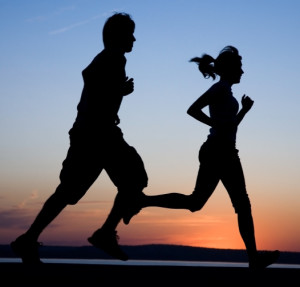 All kinds of people seek massage therapy for all kinds of different reasons. The end result is almost always pain relief and relaxation.
All kinds of people seek massage therapy for all kinds of different reasons. The end result is almost always pain relief and relaxation.
Here’s a snapshot of some of the most likely types of people who seek and benefit from regular massage. Can you find yourself or someone else you know in this list?
- Betty/Billy Back Pain. Back pain comes from joints, muscles, joints in the spine, bones, and nerves around the back. The pain could be in one area or could have a wider spread effect on an individual. A massage helps this client feel and function better compared to friends who don’t receive any massage treatment. Studies show it improves range of motion and decreases discomfort, too. Continue reading “Can You Find Yourself in these Massage Profiles?”
Tight Trapezius muscle?
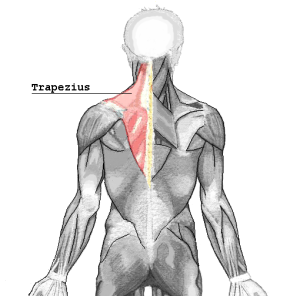 You might not know exactly where it is, but you most likely have experienced pain and strain in your Trapezius muscle. Maybe you just started working out. Maybe you swim or play tennis. Perhaps you are carrying heavy objects or been sit in one position for a long period of time. Maybe you’re just stressed. All these activities can cause your traps to tighten.
You might not know exactly where it is, but you most likely have experienced pain and strain in your Trapezius muscle. Maybe you just started working out. Maybe you swim or play tennis. Perhaps you are carrying heavy objects or been sit in one position for a long period of time. Maybe you’re just stressed. All these activities can cause your traps to tighten.
The Trapezius has three areas: upper, middle and lower. The muscle stretches from the top of your neck, out to your shoulders and a little more than half way down the center of your back.
This huge muscle performs many different functions, including moving shoulder blades in toward the spine, rotating and moving shoulder blades up and down, bringing the head and neck backward, and rotating and side bending the neck. It also assists in breathing, opening up the small amount of breathing room in the upper chest area.
For people who work at desks and computers, Continue reading “Tight Trapezius muscle?”
Ancient Egyptians Were Into Massage
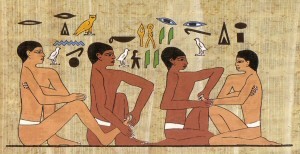 It is widely recognized that ancient Egyptians were among the first to study and categorize essential oils. They created oils, incense and perfumes and often had others apply the oils for therapeutic purposes. Welcome to massage.
It is widely recognized that ancient Egyptians were among the first to study and categorize essential oils. They created oils, incense and perfumes and often had others apply the oils for therapeutic purposes. Welcome to massage.
While the earliest definitive references to massage come from China about 5000 BCE, references to medical “healing” through massage began to show up around 3000 BCE in wall paintings and carvings.
Couples Massage May Save Your Relationship
Let’s face it. We live in an incredibly stressful world. This stresses pile up, too. They make us tense. Short-tempered. Tired. Achy. Stress can turn just about any teddy bear into a angry grizzly. All that stress doesn’t do any favors for a relationship, either.
That’s where massage comes in. It’s well known that massage is good for relaxation, but there are plenty more reasons you might want to consider massage. And pairing up with your significant other for the experience has added benefits.
Here are just a few:
Continue reading “Couples Massage May Save Your Relationship”
Sore Sartorius?
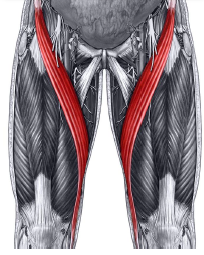 The sartorius muscle is a long, thin, band-like muscle in your interior thigh. It’s the longest muscle in the human body. The muscle primarily helps flex and rotate your thigh at the hip joint. The muscle is so long, it also crosses the knee joint, where it helps flex the leg.
The sartorius muscle is a long, thin, band-like muscle in your interior thigh. It’s the longest muscle in the human body. The muscle primarily helps flex and rotate your thigh at the hip joint. The muscle is so long, it also crosses the knee joint, where it helps flex the leg.
In your daily life, you’ll notice that the sartorius:
- Assists in raising your leg at the thigh (bringing knee to chest)
- Assists with twisting your knee inward, toward the body
- Assists moving your thigh away from the body
- Assists with bending your knee
Feel Awkward About Massage?
It’s true. Some people feel a little awkward the first time they get a massage. It’s mostly concern about the unknown; wondering what it’s like and if you will enjoy the experience.
In reality, awkward feelings fade away very quickly when you’re in the hands of a qualified professional massage therapist. They provide a safe and comfortable experience. They will talk you through the experience so you won’t feel embarrassed or uninformed.
There are a few things to know beforehand, though, that will help you feel more comfortable when you arrive for your massage. Here’s a short list:
Management of IT Band Syndrome with Massage
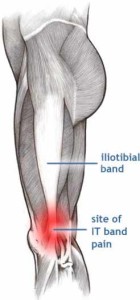 Iliotibial Band Syndrome (ITB Syndrome) is one of the most common overuse injuries among runners. You’ll know it when you have it because the “IT band“, the ligament that runs down your outer thighs from pelvis to shin, is super tight, swollen, and often inflamed. The result? Pain, sometimes severe, when flexing the knee.
Iliotibial Band Syndrome (ITB Syndrome) is one of the most common overuse injuries among runners. You’ll know it when you have it because the “IT band“, the ligament that runs down your outer thighs from pelvis to shin, is super tight, swollen, and often inflamed. The result? Pain, sometimes severe, when flexing the knee.
Some causes of IT band syndrome
ITB syndrome usually results from running on uneven surfaces, wearing work-out shoes, running too long a distance without proper training, or running too many track workouts in the same direction. ITB syndrome affects about 1 in 10 runners and is more common among women and anyone whose hips tilt in a way that causes their knees to turn in. Continue reading “Management of IT Band Syndrome with Massage”
Outcome Based Massage
 Like any fast-growing profession, the field of massage therapy is evolving all the time. As licensing and certification standards rise, and more and more massage therapists graduate from education programs that treat massage as a holistic skill, the profession is gradually expanding from a focus mainly on relaxation and overall wellness to a focus on outcome-based treatments.
Like any fast-growing profession, the field of massage therapy is evolving all the time. As licensing and certification standards rise, and more and more massage therapists graduate from education programs that treat massage as a holistic skill, the profession is gradually expanding from a focus mainly on relaxation and overall wellness to a focus on outcome-based treatments.
Outcome-based treatments allow qualified massage therapists to use evidence-based analysis to create highly personalized session strategies focusing bodywork on achieving a specific goal or goals. Clients report longer lasting relief from pain and therapists get intense satisfaction knowing they have created real and positive change.
How is it outcome based massage different?
When you seek out a massage therapist, your goals for the session can vary widely. Sometimes you want to relax, sometimes you have a specific complaint about an ache or pain, sometimes you’ve been referred by a medical professional or physical therapist.
Massage for Seniors Top Five Benefits
There is a lot for most seniors to celebrate. All those years mean you’ve grown in wisdom and pretty much figured out the world. You have had many life experiences. You have built routines in your daily life that help you stay on top of things. You may have family and friends that delight you. You might get a kick out of pursuing a hobby or interest. Senior life can be very good.
It’s not always a bed of roses, though. There are the not-so-celebratory parts of senior life. Sometimes you get achy or ill, sometimes you get lonely, sometimes you feel like you just need to get away for some well-deserved rest.
The frustrations life brings are pretty much the same no matter what age you are. Stress and strain brought on by working, dealing with day-to-day life, family, responsibilities, and getting adjusted to life as a senior can take its toll on you.
Many seniors have turned to massage to help improve the quality of their lives. It’s completely natural, incredibly effective when delivered by a qualified therapist, and has many benefits for seniors that counteract the frustrations you experience.
So Goes the Psoas
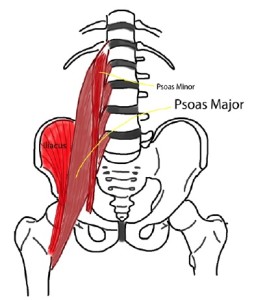 The Psoas (“so-az”) muscle helps flex the hip and stabilize the spine and is involved in everyday activities like walking and running. One of the iliopsoas group of muscles (along with the iliacus muscles), it is also is one of the most targeted muscles in discussions of lower back pain.
The Psoas (“so-az”) muscle helps flex the hip and stabilize the spine and is involved in everyday activities like walking and running. One of the iliopsoas group of muscles (along with the iliacus muscles), it is also is one of the most targeted muscles in discussions of lower back pain.
Your psoas major (so-az) muscles (you have one on each side of your spine) connect the lower portion of your back to the top of your thighs. Its major function is to stabilize the back and it’s the strongest and biggest player in a group of muscles called hip flexors that help flex your hips. Lay down and bring your knees to your chest and you’ll experience the psoas in action.
The psoas originates from the lumbar vertebrae and forms a strip of muscle about as big as your wrist along each side of the spine. It proceeds down and forward, crossing the outer edge of each pubis, then moves back again to attach on a bony prominence of the inner upper posterior femur (thigh bone) called the lesser trochanter. Continue reading “So Goes the Psoas”

